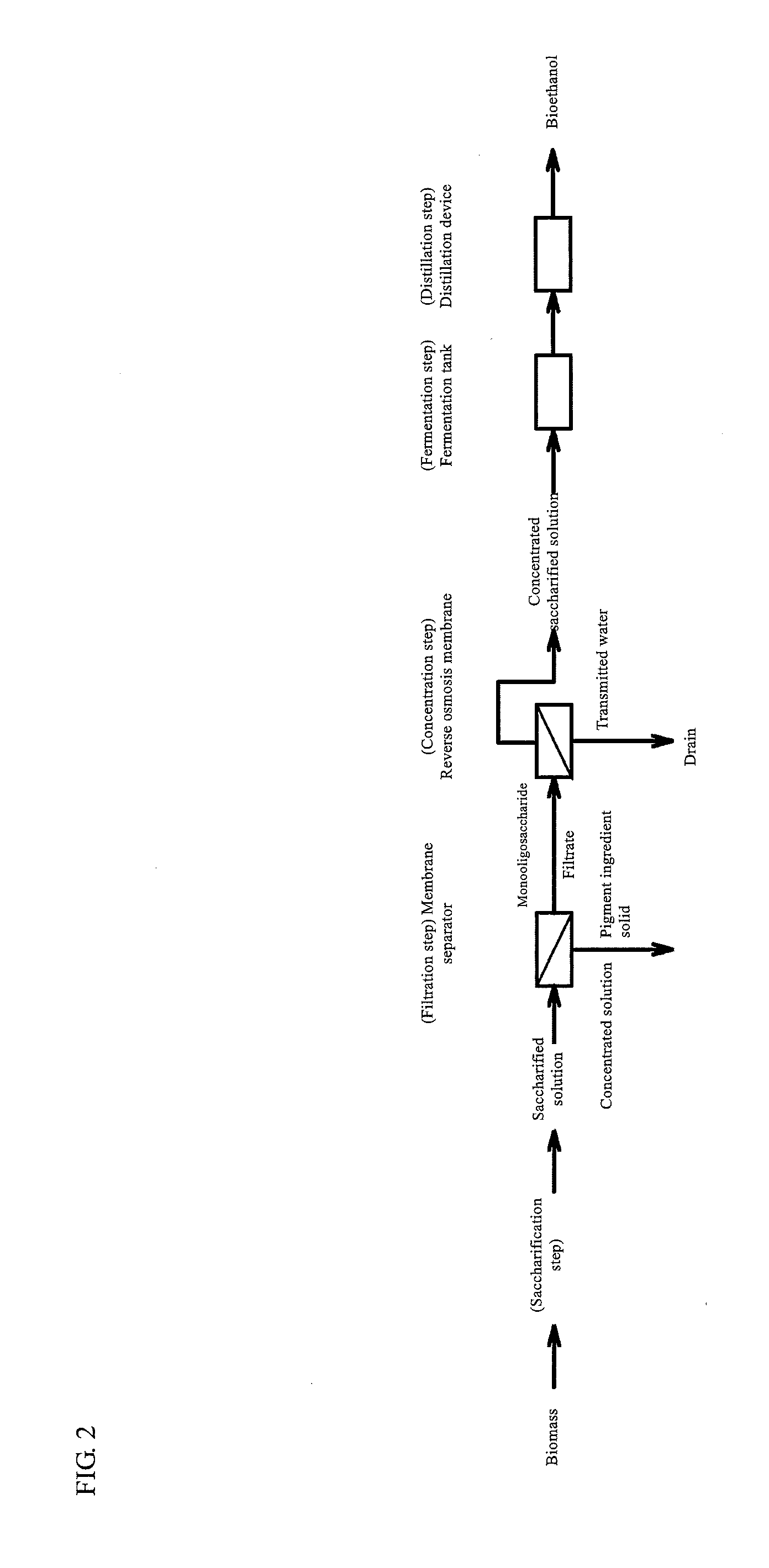Method for producing concentrated saccharified solution
a technology of concentrated saccharide and concentrated solution, which is applied in the direction of glucose production, membranes, reverse osmosis, etc., can solve the problems of inability to use as a source material for bioethanol production, failure to hydrolyze lignin contained in lignocellulosic biomass, etc., to prevent the loss of saccharide and facilitate the occurrence of fouling
- Summary
- Abstract
- Description
- Claims
- Application Information
AI Technical Summary
Benefits of technology
Problems solved by technology
Method used
Image
Examples
embodiment 1
Preparation of Source Material Slurry
[0027]FIG. 1 is a schematic flowchart of an ethanol production method according to Embodiment 1 of the present invention. As a pretreatment, lignocellulosic biomass (vegetation biomass such as bagasse, beet dregs, or straw) is ground to several millimeters or smaller. The ground cellulosic biomass is added with water and stirred to be rendered a slurry. The water content of the prepared source material slurry is preferably adjusted to 50% by mass or more and 95% by mass or less. To the source material slurry, acid such as sulfuric acid, hydrochloric acid, nitric acid, phosphoric acid or acetic acid may be appropriately added as an acid catalyst. In this case, the acid concentration in the source material slurry is preferably adjusted to 0.1% by mass or more and 10% by mass or less.
[0028](Saccharification Step)
[0029]The source material slurry is saccharified by a known biomass saccharifying method such as a hydrolysis method using strong acid, a h...
embodiment 2
[0042]FIG. 2 is a schematic flowchart of an ethanol production method according to Embodiment 2 of the present invention. Embodiment 2 is identical to Embodiment 1 in the configuration and flow except that the saccharified solution obtained by the saccharification step is assumed to contain monosaccharides such as glucose and oligosaccharides having a molecular weight of less than 1000 as the saccharides.
[0043]Oligosaccharides having a molecular weight of less than 1000 pass through the separation membrane similarly to monosaccharides, and are contained in the filtrate, which is fed to the fermentation step. The concentrated solution of the membrane separator does not contain monosaccharides and oligosaccharides, but contain lignin and its decomposition product having a molecular weight more than or equal to the molecular cutoff of the separation membrane of 1000, and solids. The concentrated solution of the membrane separator is drained outside the system.
[0044][Conventional Art]
[0...
example
[0051]Bagasse as biomass was micronized to have a mean particle size of 1 mm or less, and the saccharification step was conducted by the hydrolysis method using high temperature and high pressure water in a subcritical state. The solid in the obtained saccharified solution was separated by using quantitative filter paper No. 5C. The saccharified solution after separation of the solid was fed to the membrane separator having a ultrafiltration membrane having a nominal molecular cutoff of 6000 to conduct a filtration step. The filtrate of this membrane separator was fed to the reverse osmosis membrane device having a reverse osmosis membrane device having an effective area of 32 cm2 to measure the flux.
PUM
| Property | Measurement | Unit |
|---|---|---|
| pore size | aaaaa | aaaaa |
| mean particle size | aaaaa | aaaaa |
| area | aaaaa | aaaaa |
Abstract
Description
Claims
Application Information
 Login to View More
Login to View More - R&D Engineer
- R&D Manager
- IP Professional
- Industry Leading Data Capabilities
- Powerful AI technology
- Patent DNA Extraction
Browse by: Latest US Patents, China's latest patents, Technical Efficacy Thesaurus, Application Domain, Technology Topic, Popular Technical Reports.
© 2024 PatSnap. All rights reserved.Legal|Privacy policy|Modern Slavery Act Transparency Statement|Sitemap|About US| Contact US: help@patsnap.com










